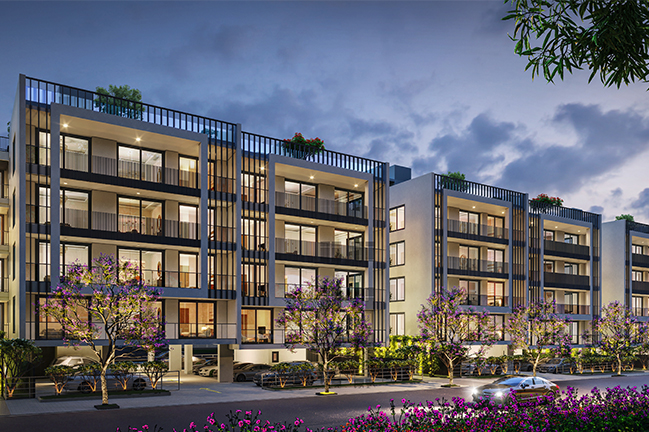
Blog
We keep you up to date on the most recent real estate news and events.
Understanding Low-Rise Living: Advantages and Considerations
The Appeal of Low-Rise Living
In recent years, the demand for low-rise housing has seen a significant rise, particularly among homebuyers seeking a balance between urban convenience and suburban tranquility. According to a report by Knight Frank India, nearly 40% of homebuyers now prefer low-rise residences over high-rise apartments due to factors like lower population density, better privacy, and more open spaces. This shift is driven by a growing desire for healthier living environments and a stronger sense of community—elements often missing in high-rise developments.
As urbanization continues to shape our cities, homebuyers are increasingly leaning towards low-rise residential developments. While high-rises dominate metropolitan skylines, low-rise homes offer a different kind of appeal—one that combines modern comfort with a serene, less congested environment. But is low-rise living the right choice for you? Let’s explore the key advantages and important considerations of choosing a home in a low-rise development.
What is Low-Rise Living?
Low-rise buildings typically consist of one to four floors and are designed to offer a more intimate, less crowded residential experience. Unlike high-rise apartments that dominate city skylines, low-rise homes can range from independent villas and townhouses to boutique apartment complexes and gated communities.
According to the National Association of Home Builders (NAHB), many homebuyers in recent years have shifted their preferences towards low-rise developments due to space, privacy, and community-oriented living (Source: NAHB Housing Trends Report).
Advantages of Low-Rise Living
1. More Space, More Privacy
One of the biggest draws of low-rise living is the expanse of space—both within the home and the surrounding environment. With fewer units per building, residents enjoy larger apartments, wider balconies, and more green spaces. Additionally, low-rise buildings often feature fewer shared walls, which significantly reduces noise disturbances.
2. Better Air Quality and Natural Light
Living in a high-rise often means dealing with pollution at elevated levels—both in terms of air and noise. Low-rise residences, particularly those in planned communities or suburban areas, offer cleaner air, better ventilation, and more exposure to natural light, creating a healthier living environment.
A study conducted by the World Green Building Council found that homes with ample natural light can improve mood, sleep patterns, and overall mental well-being (Source: WorldGBC).
3. Sense of Community
Unlike high-rises, where hundreds of residents may live in the same tower but rarely interact, low-rise developments often foster closer-knit communities. With fewer residents per building, neighbors are more likely to know each other, fostering a stronger sense of belonging and security.
4. Lower Maintenance Costs
Low-rise apartments generally come with lower maintenance fees compared to high-rise buildings. There are no expensive elevators, less complex infrastructure, and lower energy costs for common areas. According to a report by Property Management Insider, maintenance costs in low-rise buildings are, on average, 20-30% lower than those in high-rise towers (Source: Property Management Insider).
5. Easy Accessibility
For families with young children, elderly residents, or those with mobility issues, low-rise buildings are a more practical choice. With fewer floors, staircases remain manageable, and the absence of reliance on elevators means no inconvenience during power outages or technical failures.
6. Lower Population Density
Overcrowding is a common issue in high-rise apartments. Low-rise homes, on the other hand, offer a more peaceful and uncrowded living environment, reducing traffic congestion within the premises and creating quieter, more pleasant surroundings.
Considerations Before Choosing Low-Rise Living
While low-rise residences offer many advantages, it is essential to consider a few potential drawbacks before making a decision.
1. Limited Views
One of the selling points of high-rise apartments is the panoramic city skyline views they offer. Low-rise homes, being closer to the ground, may not provide the same kind of scenic outlook. However, many low-rise developments compensate with lush landscaping and open green areas.
2. Security Concerns
Higher floors in a high-rise offer better security against break-ins, while ground or first-floor units in a low-rise may be more accessible to outsiders. That said, gated communities, CCTV surveillance, and 24/7 security personnel significantly reduce risks in well-planned low-rise developments.
3. Limited High-End Amenities
Most luxury high-rise buildings come with state-of-the-art amenities such as infinity pools, sky lounges, and high-tech gyms. Low-rise buildings, depending on the developer, may have fewer luxury features. However, some gated low-rise townships offer exclusive amenities comparable to high-rises.
4. Higher Land Prices
Because low-rise properties typically require more land per unit, they may come with a higher land cost compared to vertical developments. This could mean slightly higher property prices or lower resale value appreciation in some cases.
Who Should Choose Low-Rise Living?
Low-rise residences are ideal for:
- Families looking for more space and a child-friendly environment.
- Elderly residents who prefer accessibility and a quieter setting.
- Remote workers who value peace and fresh air over city congestion.
- Homebuyers prioritizing community living over fast-paced urban settings.
According to a 2023 survey by CBRE, nearly 65% of homebuyers preferred low-density residential spaces post-pandemic, showing a strong demand for townships and low-rise developments (Source: CBRE Residential Real Estate Report).
Trident Hills is a meticulously planned premium township spanning approximately 200 acres in Panchkula, Haryana. Nestled at the foothills of the Shivalik range, this integrated township offers a harmonious blend of nature and modern living. Residents can choose from a variety of housing options, including residential plots, premium low-rise floors and high-rise residences, all designed to provide spacious and comfortable living environments. The community boasts lush green surroundings, landscaped gardens, and a range of amenities such as a clubhouse, educational and medical facilities, and smart infrastructure features like electric car charging points and CCTV surveillance. Strategically located near key landmarks like the Panchkula Golf Club and Chandigarh International Airport, Trident Hills ensures both tranquility and connectivity for its residents.
Final Thoughts: Is Low-Rise Living Right for You?
Low-rise living offers spacious homes, better air quality, stronger community ties, and lower maintenance costs—all of which contribute to a better quality of life. However, it’s important to weigh these benefits against factors like security, amenities, and land costs to make an informed decision.
If you value peace, privacy, and a stronger connection to nature, a low-rise home may be the perfect fit. But if high-end amenities, skyline views, and urban connectivity are your priorities, a high-rise might be a better option.
At the end of the day, the choice between low-rise and high-rise living depends on your lifestyle preferences, family needs, and long-term goals. Understanding these aspects will help you find a home that aligns perfectly with your vision of a fulfilling life.